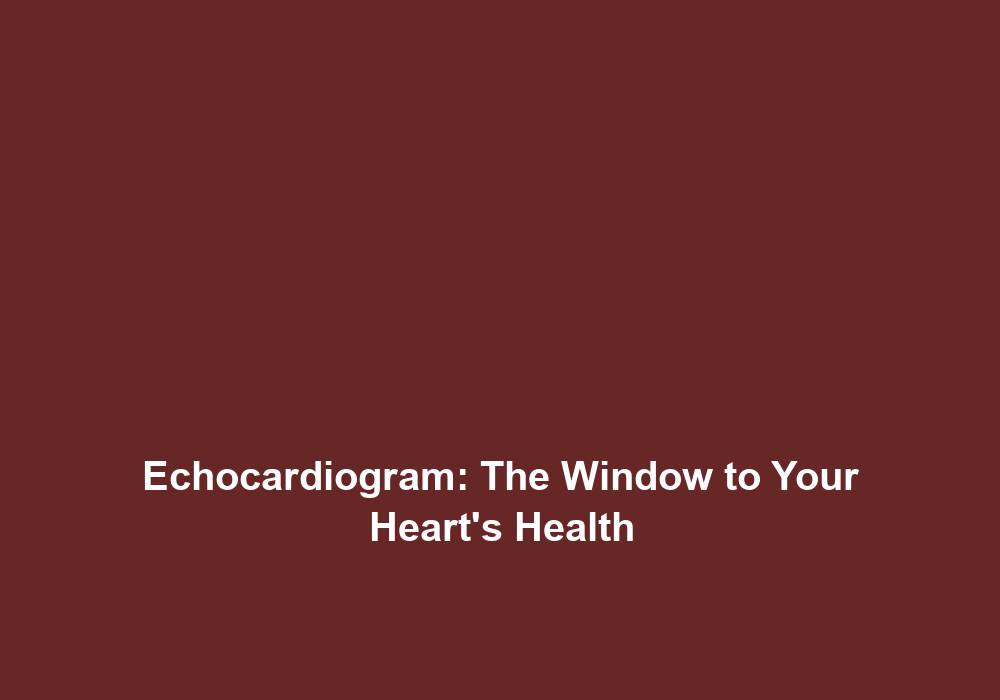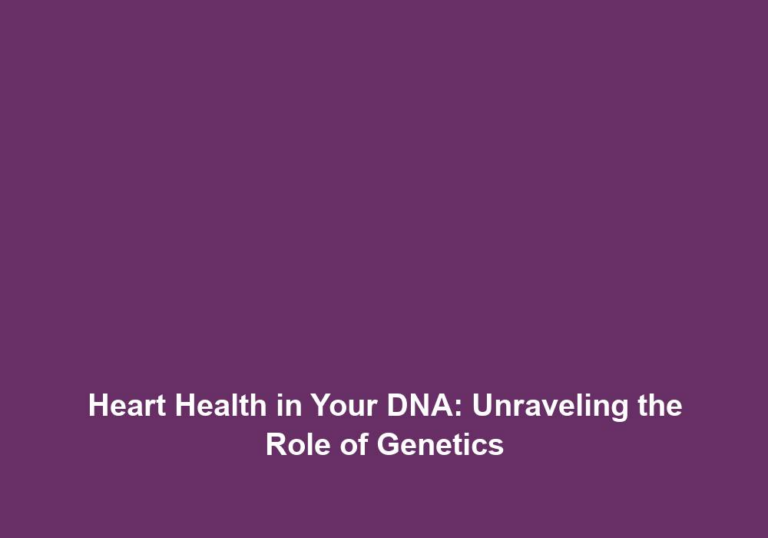Echocardiogram: The Window to Your Heart’s Health
An echocardiogram is a non-invasive diagnostic test that uses sound waves to create images of the heart. This imaging technique is instrumental in evaluating the structure and function of the heart and can provide valuable insights into an individual’s cardiovascular health. By utilizing echocardiography, healthcare professionals can accurately diagnose various heart conditions, monitor the effectiveness of treatments, and assess overall cardiac function.
What is an Echocardiogram?
An echocardiogram, often referred to as an echo, is a painless procedure that uses high-frequency sound waves, also known as ultrasound, to produce detailed images of the heart. During the test, a transducer is placed on the chest, which emits sound waves and captures the echoes as they bounce back from the heart’s structures. These echoes are then converted into real-time images that can be viewed on a monitor.
An echocardiogram is a versatile tool that provides valuable information about the heart’s structures and function. It allows healthcare professionals to examine the size, shape, and movement of the heart’s chambers, valves, and blood vessels. This detailed visualization helps in identifying abnormalities, such as congenital heart defects, heart valve disorders, coronary artery disease, and heart failure.
Moreover, an echocardiogram can also assess the pumping function of the heart, known as the ejection fraction. This measurement indicates the percentage of blood that is pumped out of the heart with each contraction. A normal ejection fraction ranges from 55% to 70%. Abnormalities in the ejection fraction can indicate conditions like weakened heart muscle or impaired cardiac function.
Why is an Echocardiogram performed?
Echocardiograms are performed for various reasons, including:
- Diagnosing Heart Conditions: Echocardiography is commonly used to diagnose heart conditions such as coronary artery disease, heart valve disorders, congenital heart defects, and heart failure. The test helps healthcare professionals identify abnormalities in the heart’s structure, assess the pumping function, and detect any signs of damage or disease.
Echocardiograms play a crucial role in diagnosing coronary artery disease (CAD), which occurs when the blood vessels that supply the heart muscle become narrowed or blocked. By assessing the blood flow through the coronary arteries, echocardiography can detect any blockages or abnormalities, helping healthcare professionals determine the appropriate treatment plan.
Additionally, echocardiograms are valuable in diagnosing heart valve disorders, such as mitral valve prolapse or aortic stenosis. These conditions involve abnormalities in the valves that regulate blood flow within the heart. Echocardiography allows for a comprehensive evaluation of the valves, including their structure, function, and any signs of regurgitation or stenosis.
- Monitoring Heart Health: Patients with known heart conditions often undergo regular echocardiograms to monitor the progression of their condition, evaluate the effectiveness of treatments, and make informed decisions regarding further management.
Regular echocardiographic assessments are essential for individuals with chronic heart conditions, such as heart failure. These evaluations help healthcare professionals track changes in the heart’s structure and function over time, allowing for early detection of any worsening of the condition. By closely monitoring the heart’s health through echocardiograms, healthcare providers can adjust medications, recommend lifestyle modifications, or consider additional interventions to optimize the patient’s cardiac function.
- Assessing Cardiac Function: Echocardiography provides valuable information about the heart’s overall function, including the strength of the heart muscle, the efficiency of blood flow, and the presence of any abnormalities or irregularities in the heart’s rhythm.
In addition to assessing the pumping function of the heart, echocardiography can evaluate the contractility of the heart muscle. This information is crucial in determining the overall strength and performance of the heart. By measuring parameters such as fractional shortening or global longitudinal strain, healthcare professionals can assess how effectively the heart is contracting and pumping blood throughout the body.
Echocardiograms are also useful in detecting any abnormalities in the heart’s electrical system, such as arrhythmias or conduction disorders. By analyzing the heart’s rhythm and electrical signals, healthcare providers can identify irregularities and determine the appropriate treatment strategy.
- Screening for Potential Issues: In some cases, echocardiograms may be used as a screening tool to identify potential heart problems in individuals who are at high risk, such as those with a family history of heart disease or individuals with certain medical conditions.
Screening echocardiograms are particularly beneficial for individuals with a family history of heart disease or those who have risk factors such as hypertension, diabetes, or high cholesterol levels. These tests can help identify any structural abnormalities or early signs of heart disease, allowing for early interventions and preventive measures.
Types of Echocardiograms
There are several types of echocardiograms, each with its specific purpose and level of detail:
- Transthoracic Echocardiogram (TTE): This is the most common type of echocardiogram, where the transducer is placed on the chest wall to obtain images of the heart from the outside. TTE provides a comprehensive assessment of the heart’s structure and function, including the valves, chambers, and blood flow.
Transthoracic echocardiograms are the standard initial imaging modality for evaluating the heart. They provide valuable information about the heart’s size, shape, and function. TTE can assess the thickness and movement of the heart walls, evaluate the function of the heart valves, measure the flow of blood through the chambers, and detect any abnormalities or structural defects.
- Transesophageal Echocardiogram (TEE): In a TEE, a specialized transducer is inserted into the esophagus to obtain clearer and more detailed images of the heart. TEE is particularly useful for assessing the heart’s structures that are located behind the breastbone and lungs.
Transesophageal echocardiograms are performed when a more detailed evaluation of the heart is required. By placing the transducer in the esophagus, healthcare professionals can obtain high-resolution images of the heart’s structures, such as the atria, ventricles, valves, and major blood vessels. TEE is especially helpful in visualizing blood clots, infective endocarditis, or assessing prosthetic heart valves.
- Stress Echocardiogram: This type of echocardiogram is performed while the patient exercises or undergoes pharmacological stress (if unable to exercise). By measuring the heart’s response to stress, healthcare professionals can assess its function and detect any potential blockages or abnormalities in blood flow.
Stress echocardiograms are utilized to evaluate the heart’s response to exercise or pharmacological stress. By combining echocardiography with physical activity or medication, healthcare providers can assess the heart’s blood flow and function under conditions that mimic real-life situations. This test is particularly useful in detecting coronary artery disease or determining the effectiveness of interventions like bypass surgery or angioplasty.
Benefits and Limitations of Echocardiography
Echocardiography offers several advantages as a diagnostic tool:
-
Non-invasive: Echocardiograms are non-invasive, meaning they do not require any incisions or exposure to radiation. This makes them a safe and painless option for patients of all ages.
-
Real-time Imaging: Echocardiography provides real-time imaging, allowing healthcare professionals to observe the heart’s structures and function immediately. This enables swift diagnosis and appropriate treatment planning.
-
Highly Accurate: Echocardiograms are highly accurate in diagnosing various heart conditions, with sensitivity and specificity comparable to other imaging techniques like cardiac MRI or CT scans.
-
Portable and Widely Available: Echocardiography machines are portable and readily available in most medical facilities, making them easily accessible for patients who require testing.
However, it is important to note that echocardiography has certain limitations:
-
Limited Visual Access: Echocardiograms provide excellent visualization of the heart’s structures but may have limited access to certain areas due to interference from the ribs, lungs, or other anatomical structures.
-
Operator Dependency: The accuracy and quality of the echocardiogram images are highly dependent on the operator’s skill and experience. A well-trained and skilled sonographer or cardiologist is crucial to obtain accurate and reliable results.
Conclusion
Echocardiograms are invaluable tools in assessing and monitoring the health of your heart. By providing detailed images of the heart’s structures and function, these tests aid in diagnosing heart conditions, evaluating treatment effectiveness, and assessing overall cardiac health. With their non-invasive nature, accuracy, and wide availability, echocardiograms have become an essential component of modern cardiology, allowing healthcare professionals to gain a clear window into the intricate workings of the heart.







